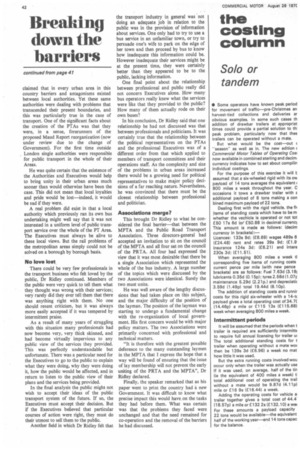the costing column
Page 44

If you've noticed an error in this article please click here to report it so we can fix it.
Solo or tandem
• Some operators have known peak period for movement of traffic—pre-Christmas an harvest-tied collections and deliveries ar obvious examples. In some such cases th addition of drawbar trailers at appropriat times could provide a partial solution to thi peak problem, particularly now that thes trailers can be operated without a mate.
But what would be the cost—out r "season" as well as in. The new edition r Commercial Motor Tables of Operating Con now available in combined sterling and decim, currency indicates how to set about compilin individual costings.
For the purpose of this exercise it will assumed that a six-wheeled rigid with its ow payload of 14 tons averages the equivalent t 800 miles a week throughout the year. 0 occasions it tows a drawbar trailer with a additional payload of 8 tons making a con bined maximum payload of 22 tons.
Dealing first with the rigid vehicle, the fh items of standing costs which have to be m whether the vechicle is operated or not tot £50 17s 6d (or £50.88 in decimal currency This amount is made as follows: (decim currency in brackets):— Licences: 133s 9d; (£6.69) wages 489s 6 ((:24.48) rent and rates 39s 9d; If 1.9 insurance 124s 3d; ((:6.21) and intere 230s 3d; ((:11.51).
When averaging 800 miles a week ti corresponding five items of running costs current pence per mile (with new pence brackets) are as follows: Fuel 7.63d (3.181 lubricants 0.35d (0.15p); tyres 2.58d 11.07p maintenance 5.29d (2.21p.) and depreciatic 3.59d (1.49p) total 19.44d (8.10p).
The addition of standing costs and runnir costs for this rigid six-wheeler with a 14-tc payload gives a total operating cost of 34.7( (14.46p) a mile or £115 13s ((:115.66) week when averaging 800 miles a week.
Intermittent periods
It will be assumed that the periods when t trailer is required are sufficiently intermitta to require full annual licensing for trailer Li! The total additional standing costs for trailer when operating without a mate wot then be 139s 3d ((:6.96) a week no mat how little it was used.
But the extra running costs involved wou occur only when the trailer was actually use If it was used, on average, half of the tin lie the equivalent of 400 miles a week) ti total additional cost of operating the trail without a mate would be 9.87d (4.1 1p) mile or £16 9s ((:16.44) a week.
Adding the operating costs for vehicle a trailer together gives a total cost of 44.4' (18.57p) a mile or £132 2s (£132.10) a we For these amounts a payload capacity 22 tons would be available—the equivalent half of the working year—and 14 tons capac for the balance.
































































































